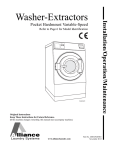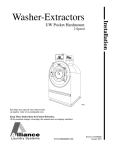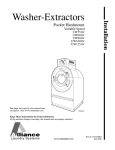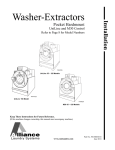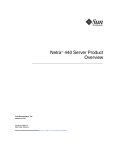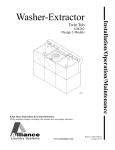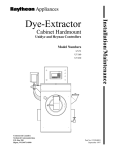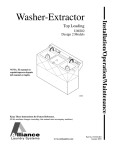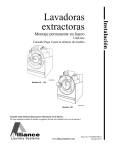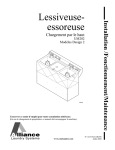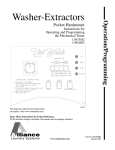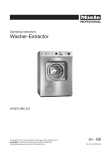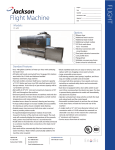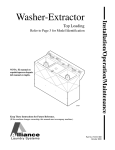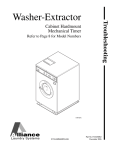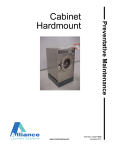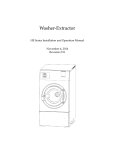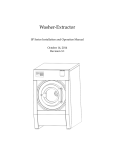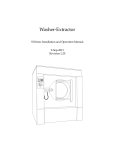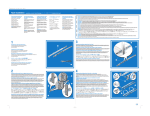Download Alliance Laundry Systems UW50P-4 User's Manual
Transcript
Installation/Maintenance Washer-Extractors Pocket Hardmount WE-6 Control UW50P-4 P031I Keep These Instructions for Future Reference. (If this machine changes ownership, this manual must accompany machine.) www.comlaundry.com Part No. F232158 September 2002 Table of Contents Introduction......................................................................................... Nameplate Location.............................................................................. Replacement Parts ................................................................................ Customer Service.................................................................................. 3 3 3 3 Safety Information.............................................................................. Important Safety Instructions ............................................................... 5 5 Installation........................................................................................... Specifications and Dimensions............................................................. Machine Foundation ............................................................................. Floor Load Data ............................................................................... Mechanical Installation......................................................................... Drain Connection.................................................................................. Water Connection ................................................................................. Electrical Installation ............................................................................ Input Voltage Requirements ............................................................ Connection Specifications ............................................................... Electrical Connection Data .............................................................. Grounding ........................................................................................ Phase Adder ..................................................................................... Control Function Test Procedure ..................................................... 7 7 10 10 11 13 15 16 16 16 17 18 18 18 Maintenance ........................................................................................ General.................................................................................................. Daily ..................................................................................................... Monthly................................................................................................. Care and Maintenance of Stainless Steel.............................................. Daily Preventive Maintenance Checklist.............................................. Weekly Preventive Maintenance Checklist .......................................... Monthly Preventive Maintenance Checklist......................................... Quarterly Preventive Maintenance Checklist ....................................... 19 19 19 19 20 21 22 23 24 Removal from Service ........................................................................ 25 Decommissioning ................................................................................. 25 © Copyright 2002, Alliance Laundry Systems LLC All rights reserved. No part of the contents of this book may be reproduced or transmitted in any form or by any means without the expressed written consent of the publisher. F232158 © Copyright, Alliance Laundry Systems LLC – DO NOT COPY or TRANSMIT 1 Notes 2 © Copyright, Alliance Laundry Systems LLC – DO NOT COPY or TRANSMIT F232158 Introduction Nameplate Location Replacement Parts The nameplate is located at the top of the machine. Always provide the machine’s serial number and model number when ordering parts or when seeking technical assistance. If literature or replacement parts are required, contact the source from which the machine was purchased or contact Alliance Laundry Systems at (920) 748-3950 for the name and address of the nearest authorized parts distributor. 1 Customer Service For technical assistance, call any of the following numbers: (850) 718-1025 (850) 718-1026 Marianna, Florida U.S.A. (920) 748-3121 Ripon, Wisconsin U.S.A. PHM516N PHM516N 1 F232158 Nameplate © Copyright, Alliance Laundry Systems LLC – DO NOT COPY or TRANSMIT 3 Notes 4 © Copyright, Alliance Laundry Systems LLC – DO NOT COPY or TRANSMIT F232158 Safety Information Precautionary statements (“DANGER,” “WARNING,” and “CAUTION”), followed by specific instructions, are found in this manual and on machine decals. These precautions are intended for the personal safety of the operator, user, servicer, and those maintaining the machine. DANGER DANGER indicates the presence of a hazard that will cause severe personal injury, death, or substantial property damage if the danger is ignored. WARNING WARNING indicates the presence of a hazard that can cause severe personal injury, death, or substantial property damage if the warning is ignored. CAUTION CAUTION indicates the presence of a hazard that will or can cause minor personal injury or property damage if the caution is ignored. Additional precautionary statements (“IMPORTANT” and “NOTE”) are followed by specific instructions. IMPORTANT: The word “IMPORTANT” is used to inform the reader of specific procedures where minor machine damage will occur if the procedure is not followed. NOTE: The word “NOTE” is used to communicate installation, operation, maintenance or servicing information that is important but not hazard related. Important Safety Instructions WARNING To reduce the risk of fire, electric shock, serious injury or death to persons when using your washer, follow these basic precautions: W023E 1. Read all instructions before using the washer. 2. Refer to the GROUNDING INSTRUCTIONS in the INSTALLATION manual for the proper grounding of the washer. 3. Do not wash textiles that have been previously cleaned in, washed in, soaked in, or spotted with gasoline, dry-cleaning solvents, or other flammable or explosive substances as they give off vapors that could ignite or explode. 4. Do not add gasoline, dry-cleaning solvents, or other flammable or explosive substances to the wash water. These substances give off vapors that could ignite or explode. 5. Under certain conditions, hydrogen gas may be produced in a hot water system that has not been used for two weeks or more. HYDROGEN GAS IS EXPLOSIVE. If the hot water system has not been used for such a period, before using a washing machine or combination washer-dryer, turn on all hot water faucets and let the water flow from each for several minutes. This will release any accumulated hydrogen gas. The gas is flammable, do not smoke or use an open flame during this time. 6. Do not allow children to play on or in the washer. Close supervision of children is necessary when the washer is used near children. This is a safety rule for all appliances. 7. Before the washer is removed from service or discarded, remove the door to the washing compartment. 8. Do not reach into the washer if the wash drum is moving. F232158 © Copyright, Alliance Laundry Systems LLC – DO NOT COPY or TRANSMIT 5 Safety Information 9. Do not install or store the washer where it will be exposed to water and/or weather. 10. Do not tamper with the controls. 11. Do not repair or replace any part of the washer, or attempt any servicing unless specifically recommended in the user-maintenance instructions or in published user-repair instructions that the user understands and has the skills to carry out. 12. To reduce the risk of an electric shock or fire, DO NOT use an extension cord or an adapter to connect the washer to the electrical power source. 13. Use washer only for its intended purpose, washing textiles. 14. ALWAYS disconnect the washer from electrical supply before attempting any service. Disconnect the power cord by grasping the plug, not the cord. 15. Install the washer according to the INSTALLATION INSTRUCTIONS. All connections for water, drain, electrical power and grounding must comply with local codes and be made by licensed personnel when required. 16. To reduce the risk of fire, textiles which have traces of any flammable substances such as vegetable oil, cooking oil, machine oil, flammable chemicals, thinner or anything containing wax or chemicals such as in mops and cleaning cloths, must not be put into the washer. These flammable substances may cause the fabric to catch on fire by itself. 17. Do not use fabric softeners or products to eliminate static unless recommended by the manufacturer of the fabric softener or product. 18. Keep washer in good condition. Bumping or dropping the washer can damage safety features. If this occurs, have washer checked by a qualified service person. 6 19. Replace worn power cords and/or loose plugs. 20. Be sure water connections have a shut-off valve and that fill hose connections are tight. CLOSE the shut-off valves at the end of each wash day. 21. Loading door MUST BE CLOSED any time the washer is to fill, tumble or spin. DO NOT bypass the loading door switch by permitting the washer to operate with the loading door open. 22. Always read and follow manufacturer’s instructions on packages of laundry and cleaning aids. Heed all warnings or precautions. To reduce the risk of poisoning or chemical burns, keep them out of the reach of children at all times (preferably in a locked cabinet). 23. Always follow the fabric care instructions supplied by the textile manufacturer. 24. Never operate the washer with any guards and/or panels removed. 25. DO NOT operate the washer with missing or broken parts. 26. DO NOT bypass any safety devices. 27. Failure to install, maintain, and/or operate this washer according to the manufacturer’s instructions may result in conditions which can produce bodily injury and/or property damage. NOTE: The WARNINGS and IMPORTANT SAFETY INSTRUCTIONS appearing in this manual are not meant to cover all possible conditions and situations that may occur. Common sense, caution and care must be exercised when installing, maintaining, or operating the washer. Any problems or conditions not understood should be reported to the dealer, distributor, service agent or the manufacturer. © Copyright, Alliance Laundry Systems LLC – DO NOT COPY or TRANSMIT F232158 Installation Specifications and Dimensions Description Stainless Steel Cylinder Frame (Note) Shaft Shell Shell Door Safety Interlock Spray FlushRinse* Bearings and Seals Suds Overflow Connection Drain Valve Water Inlet Valves Automatic Supply Injection* F232158 UW50 shall be a Heavy Duty Stainless Steel Open End. Open Pocket combination laundry washerextractor, equipped with standard deep rinse, plus through-the-door spray rinse which is capable of rinsing during the extract cycle and producing up to three loads per hour. Machine shall have direct Vbelt drive without transmission, gears or variable-speed pulleys to reduce mechanical problems. Type 304 corrosion resistant stainless steel must be used for the front panel, cylinder shell, shell door, basket, side panels, control unit and top. Cylinder size shall be 32 inch diameter by 18 inch depth. There shall be four lifters with a tie rod through lifter being not less than 1/2 inch stainless steel. The cylinder shall have a full size steel back plate not less than 1/2 inch in thickness. The frame shall be heavy duty gamma A-type with main support sides being 9 inch channel steel. The A face plates will be a minimum of 3/8 inch thickness. The frame base will be constructed of 4 inch steel H beam. Various other supports will be of 2-1/2 inch x 2-1/2 inch x 1/4 inch angle and 2 inch x 1/2 inch flat steel. The cylinder shaft shall be of AISI-C-1042 turned, ground and polished. It shall have a minimum diameter of 2-7/16 inches. The entire shell shall be of stainless steel, including all fittings and means of securing the shell. All welds are heliarced. The shell door shall be of stainless steel, suitably polished. The door opening shall be a minimum of 17-1/2 inches in diameter and door shall be fitted with a proper door gasket and a suitable operating door handle. A circular door glass of specially treated high tensile strength glass capable of withstanding high mechanical and thermal shock shall be provided. The shell door shall have an interlock device which shall prevent operation of the machine until the door is closed and locked. There shall also be a “fail safe” type of lock that will prevent the door from being opened until the end of the cycle and also in case of loss of power to the machine. The spray flush-rinse shall consist of a suitable hose of a minimum inside diameter of 3/4 inch, and suitable fittings to introduce a spray through the center of the glass on the door. The front and rear main bearings shall be self-aligning double row spherical roller bearings. Bearings shall be installed in an adequate bearing housing which can be rigidly secured to the frame. Seal design shall be of a mechanical face seal giving good protection against alkalis and acids. The seal incorporates means to compensate for variation in shaft length due to expansion and contraction. A 2 inch pipe size overflow connection will be provided. The machine shall be equipped with a 2-1/2 inch pinch type gravity drain valve which will be open with power removed. The machine shall be equipped with two or four 1/2 inch (two hot and two cold) solenoid operated inlet valves of heavy brass. The solenoid coils must be waterproof and mechanically protected. A four-pocket supply injector shall automatically add washing supplies at correct time in formula. Supply compartments shall be filled at beginning of each load. Supplies shall not be flushed into washer until the proper water level has been reached. © Copyright, Alliance Laundry Systems LLC – DO NOT COPY or TRANSMIT 7 Installation Specification UW50 Dimensions Width 36 in. (915 mm) Depth 40 in. (1015 mm) Height 63 in. (1600 mm) Weight Net 1350 lbs. (612 kg) Gross 1410 lbs. (640 kg) Cylinder Volume 8.40 cu. ft. (238 l) Diameter 32 in. (810 mm) Depth 18 in. (457 mm) Wash Speed 44 RPM Drain Speed 73 RPM Medium Speed 350 RPM Extract Speed 700 RPM G-Factor Extract 222 Motor Power Wash Speed 0.60 HP (0.45 kW) Drain Speed 0.75 HP (0.56 kW) Medium Speed 3.0 HP (2.2 kW) Extract 3.5 HP (2.6 kW) Motor Speed Wash Speed 360 RPM/60 Hertz 290 RPM/50 Hertz Extract Speed 3350 RPM/60 Hertz 2780 RPM/50Hertz Water Connect Size 3/4 in. (DN20) Operating Pressure 10-120 psi (0.5-8 bar) Recommended Pressure 30-85 psi (2-6 bar) Maximum Temperature 200°F (90°C) Steam Connect Size 1/2 in. NPT (DN15 mm) Maximum Pressure 120 psi (8 bar) Drain Connect I.D. Size 3 in. (75 mm) 90.15 cu. ft. (2.55 m3) Shipping Volume Table 1 8 © Copyright, Alliance Laundry Systems LLC – DO NOT COPY or TRANSMIT F232158 Installation 36 in. (915 mm) 40 in. (1016 mm) 63 in. (1600 mm) 1 in. (25 mm) 28.5 in. (725 mm) 35.62 in. (905 mm) 36 in. (915 mm) 56 in. (1420 mm) 15.5 in. (395 mm) PHM517N F232158 © Copyright, Alliance Laundry Systems LLC – DO NOT COPY or TRANSMIT 9 Installation Machine Foundation A base designed to elevate the UW50 to a comfortable and more accessible height for loading and unloading laundry may be used. Care must be exercised in the design of such a base due to the force exerted by the machine during extract (222 Gs). The machine must be secured to a foundation or floor of adequate construction. Detail must be stressed with all foundation work to ensure a stable unit installation, eliminating possibilities of excessive vibration. The machine must be anchored to a smooth level surface so that the entire base of the machine is supported and rests on the mounting surface. Do not support the machine on only four points. Anchor bolts must be a minimum of 3/4 inch diameter, grade 2. Refer to Mechanical Installation. Static and dynamic loads on the floor or foundation are shown in Table 2. This table can be used as a reference when designing floors and foundations. NOTE: Machine must be installed on concrete floor that is a minimum of 12 inches thick. Do not mount on wooden floors. Do not install above ground floor. Floor must be solid. Floor Load Data Model UW50-4 Maximum Floor Load Frequency of Dynamic at Extraction Speed Load Combined Static and Dynamic Floor Load Mounting Bolt Size lbs. kN Cycles (Hz) lbs. kN lbs./ sq. ft. kN/m2 inch mm 1575±2220 7.0±9.9 11.67 3795 16.9 425.9 20.39 3/4 M20 Table 2 10 © Copyright, Alliance Laundry Systems LLC – DO NOT COPY or TRANSMIT F232158 Installation Mechanical Installation 1 A proper foundation is absolutely necessary for the UW50P-4 due to its high extract speed and the G-force exerted. 2 A bolt kit is available as an option consisting of eight 3/4 inch bolts, 8 inches long, which should be imbedded in a reinforced concrete floor that is a minimum of 12 inches thick. 3 4 0.75 in. (19 mm) 1 2 5 3 2 in. (51 mm) PHM179N TYPICAL METHOD OF MOUNTING USING BASE FRAME 8 in. (203 mm) PHM179N 4 5 TYPICAL METHOD OF MOUNTING USING INDIVIDUAL MOUNTING BOLTS 1 2 3 4 5 Machine Base Bolt Threads Grouting – 1/2 in. Thick Reinforcing Rod 3/4 in. x 8 in. Bolt Figure 2 PHM178N NOTE: Existing floor must be a minimum of 12 inches thick. 1 2 3 4 5 Machine Base Piece of Angle Welded to Bolt to Prevent Turning Grouting – 1/2 in. Thick 3/4 in.-10 x 8 in. Bolt Conical hole drilled or chiseled into existing floor. Fill with “Sulfaset” bolt or equivalent. Figure 1 The threaded end of the bolts should extend 2 inches above the surface of the floor. Refer to Figure 3 for the location of these bolts. A bolt locator fixture (base frame), consisting of a rigid welded assembly made of reinforcing rod welded to the eight 3/4 inch bolts which may be embedded in the concrete as one piece is also available as an option. Refer to Figure 2. Be sure the bolt threads also extend 2 inches above the floor. F232158 © Copyright, Alliance Laundry Systems LLC – DO NOT COPY or TRANSMIT 11 Installation 0.75 in. (19 mm) 34.12 in. (867 mm) 0.75 in. (19 mm) 4.81 in. (122 mm) 44.81 in. (1138 mm) 1.25 in. (32 mm) 9 in. (229 mm) 10.75 in. (273 mm) 39.25 in. (997 mm) 34.56 in. (878 mm) 36 in. (914 mm) 10.69 in. (271 mm) PHM518N FRONT 2 in. (51 mm) X = 5 FEET 31.62 in. (803 mm) 2 in. (51 mm) 35.62 in. (905 mm) 0.75 in. (19 mm) Figure 4 MOUNTING BOLT LAYOUT PHM191N Figure 3 PHM518N If the existing floor is not reinforced concrete a minimum of 12 inches thick over a solid base, it will be necessary to cut a hole through existing floor approximately 5 feet square and excavate to a depth of 36 inches from top of existing floor. Slope the edges of the hole outwards so that the hole is pyramid shaped. Excavate under existing floor 5 inches beyond the required 5 feet square all around. Refer to Figure 4 where x = 5 feet. Refill with 24 inches of well compacted clean fill dirt topped with 12 inches of reinforced concrete. Imbed mounting bolts or base frame when pouring concrete. Make sure that the bolt threads extend 2 inches above the floor level. After the foundation for the machine has been prepared and the concrete has cured, proceed as follows: 1. Place the machine adjacent to the foundation. Do not attempt to move the machine by pushing on the sides. Always use a pry bar or other device at the bottom of the machine. Remove the wood skid. 12 © Copyright, Alliance Laundry Systems LLC – DO NOT COPY or TRANSMIT F232158 Installation Drain Connection Providing an adequate drain arrangement and capacity is essential. Ideally, the machine should dump through a 3 inch pipe directly into a sump or floor drain. 11.63 in. (295 mm) 35.75 in. (908 mm) 27.63 in. (702 mm)PHM518N 12.13 in. (308 mm) 4 in. TYP. (102 mm) Connection to a drain must be vented to prevent an airlock or siphon effect and must be flexible. Increasing drain hose length, installing elbows or causing bends will decrease drain flow rate which might harm washer performance. If the drain arrangement is inadequate, the machine will not extract properly nor will it discharge all the water. If proper drain line size is not available or practical, a surge tank of adequate design would be required. 35.63 in. (905 mm) 1 GROUTING DIAGRAM – APPLY GROUT IN ALL SHADED AREAS UNDER FRAME MEMBERS. PHM519N REMOVE COVER PANELS FOR ACCESS. 2 PHM519N Figure 5 2. Set machine over bolts and shim the machine so that it sits level and is 1/2 inch off the floor. Apply machine grout between the floor and all frame members of the base of the machine (remove front panel and expanded metal back panel to gain access to all frame members). Force grout under machine base until all voids are filled. Refer to Figure 5. 3 4 Leave a small opening for water drainage at the rear of the machine. Do not omit this step. 3. After grout has cured, place washers and nuts on bolts and tighten securely. Be sure nuts are tightened evenly all around. DO NOT DISTORT MACHINE BY BOLTING DOWN ON AN UNEVEN FLOOR SURFACE. NOTE: Make sure to retighten the anchor bolts after a few days of operation. PHM528N 1 2 3 4 Rear of Machine Drain Assembly Waste Line Tee – 3 in. Minimum Waste Line – 4 in. Minimum Figure 6 F232158 © Copyright, Alliance Laundry Systems LLC – DO NOT COPY or TRANSMIT 13 Installation 1 2 1 17 in. (430 mm) 21 in. (530 mm) 2 7 in. (180 mm) 4 3 3 4 TOP VIEW PHM520N 5 6 TYPICAL TROUGH DRAIN ARRANGEMENT PHM183N PHM183N 1 2 3 4 5 6 PHM520N 1 2 3 4 Steam Inlet Connection – 1/2 in. NPT Drain Connection 3 in. PVC Water Inlet Connection – 3/4 in. NPT Door Open Figure 8 Rear of Machine Drain Assembly Steel Grate Drain Trough Strainer Waste Line Figure 7 A surge tank should also be used in conjunction with a sump pump when gravity drainage is not possible. At the rear of the machine, on a centerline 15-1/2 inches from the floor, is a 3 inch PVC pipe connection for the drain. Drainage is by gravity. 14 © Copyright, Alliance Laundry Systems LLC – DO NOT COPY or TRANSMIT F232158 Installation Water Connection Separate hot and cold plumbing lines (3/4 inch pipe or larger) with individual shut-off valves must be provided. Hot water should be a minimum of 160°F. Best performance will be realized if water is provided at a pressure of 30-85 psi. Although the machine will function properly at a lower pressure, excessive fill times will occur. Use flexible hoses or equivalent flexible lines. The hoses should hang in a large loop. Do not allow to kink. Flush the water system and check filters in machine inlet hoses for proper fit and cleanliness before connecting. Each of the hoses should have a screen filter installed to keep rust and other foreign particles out of the solenoid valves. These connections should be supplied by a hot and a cold water line at least 3/4 inch size for each. Installation of additional washers will require proportionately larger water lines. Refer to Table 3. Suitable air cushions should be installed in supply lines to prevent “hammering.” If the water pressure is above 60 psi, flexible copper tubing should be used in place of the rubber hoses. Water and Drain Line Requirements Number of Machines Pipe Sizes Minimum Drain 1 3/4 in. 3 in. I.D. 2 1-1/4 in. 4 in. I.D. 3 1-1/2 in. 5 in. I.D. 4 1-1/2 in. 5 in. I.D. 5 2 in. 6 in. I.D. The UW50 has a total of four hose connections. Each pair of hoses is connected to a hot and cold water faucet with a 3/4 inch hose bib. Each machine requires incoming water connections as follows: Four 3/4 inch faucets with 3/4 inch hose bib connected to two 3/4 inch hot water faucet lines and two 3/4 inch cold water faucet lines. Table 3 1 1 2 Y041I 2 Y041I 1 2 3/4 in. Cold Water Supply Line 3/4 in. Faucet Lines Figure 9 PHM184N PHM184N 1 2 Risers (Air Cushions) Water Supply Faucets Figure 10 F232158 © Copyright, Alliance Laundry Systems LLC – DO NOT COPY or TRANSMIT 15 Installation Electrical Installation Use wire sizes indicated in the Electrical Specifications chart for runs up to 50 feet (15 m). Use next larger size for runs of 50 to 100 feet (15 to 30 m). Use two sizes larger for runs greater than 100 feet (30 m). WARNING Hazardous Voltage. Can cause shock, burn or cause death. Allow machine power to remain off for two minutes prior to working in and around AC inverter drive. The UW50 is provided with a thermal overload protector in the drive motor windings and a separate fuse for the control circuit. However, a separate threephase circuit breaker must be installed for protection against shorts. DO NOT USE FUSES. W359 WARNING Hazardous Voltage. Can cause shock, burn or death. Verify that a ground wire from a proven earth ground is connected to the lug near the input power block on this machine. For proper over current protection, the circuit breaker should be a 30 Amp capacity unit rated for 208-240 Volts and should be a three-phase breaker so that in the event that one leg should be removed from the machine, all three legs will be disconnected to prevent damage to the motor. WARNING W360 Input Voltage Requirements If input voltage measures above 240 Volt for a 200 Volt drive or above 440 Volt for a 400 Volt drive, ask the power company to lower voltage. For voltages above or below listed specifications, contact Customer Service or a distributor for buck/ boost transformer recommendation. If machine is intended for four-wire service, a neutral leg must be provided by power company. If a delta supply system is used on a four-wire model, connect high leg to L3. IMPORTANT: Improper connections will result in equipment damage and will void warranty. Connection Specifications IMPORTANT: Connection must be made by a qualified electrician using wiring diagram provided with machine, or according to accepted European standards for CE-approved equipment. Turn off power and water before attempting any maintenance, repairs, or service, or before opening any service panel or door. This machine must be connected and grounded in accordance with the National Electric Code and/or any other applicable code. W448 The wire for the service connection should be a minimum size of 8 gauge (AWG) for 208-240 Volt installations. Refer to Table 7. The connections should be made by a qualified electrician and in accordance with the wiring diagram provided with the machine. When the machine is started, check that the cylinder rotates in the correct direction during the spin (extract) step, i.e., clockwise as seen from the front of the machine. If the machine rotates in the wrong direction, two of the lines are to be interchanged at the power connection terminal (reverse L1 and L2 – do not reverse L3). Connect machine to an individual branch circuit not shared with lighting or other equipment. Shield connection in a liquid-tight or approved flexible conduit. Proper conductors of correct size must be installed in accordance with National Electric Code or other applicable codes. 16 © Copyright, Alliance Laundry Systems LLC – DO NOT COPY or TRANSMIT F232158 Installation Electrical Connection Data Model Volt Phase Cycle Max. Amps UW50 240 3 60 13 White N Red T (L3) Blue S (L2) Black R (L1) TO CONTROL MODULE Table 4 Circuit Breaker Wire Size 30 Amp 8 AWG Table 5 For Machines with Other Voltages Volt Max. Amps Wire Size Circuit Breaker 440-480 8 10 AWG 25 Amp 380-415 8 10 AWG 25 Amp 1 J-BOX MOUNTED ON REAR OF CONTROL MODULE PHM185N 1 Ground Lug Connect to Proven Earth Ground Table 6 Figure 11 For Machines with Electric Heat Volt Max. Amps Wire Size Circuit Breaker 220 65 6 AWG 70 Amp 380-415 37 8 AWG 40 Amp Table 7 Use wire size indicated in Table 7 for runs up to 50 feet. Use next larger size for runs of 50-199 feet. Use two sizes larger for runs greater than 100 feet. This protects against voltage drop which would result in a reduction of starting toque. Electrical connections are made at the J-box located on the rear of the control module. The machine must be connected to the proper electrical supply shown on the identification plate attached to the side of the control module. F232158 Do not connect the ground to the neutral (N-white wire) leg at the J-box terminal strip. If the machine is intended for 4 wire service, a neutral leg must be provided by the power company. Do not connect the neutral leg to the ground lug. If a Delta Supply System is used, the high leg must be connected to the red wire (L3) at the J-box terminal strip. If three-phase service is not available and a RotoPhase or other phase adder is used, the artificial leg must be connected to the red wire (L3). Improper connections will result in equipment damage and will void the warranty. It is your responsibility to have all electrical connections made by a properly licensed and competent electrician. assure that the electrical installation is adequate. Rotation should be clockwise in spin. To change direction of rotation, interchange the black (L1) and blue (L2) leads. © Copyright, Alliance Laundry Systems LLC – DO NOT COPY or TRANSMIT 17 Installation Grounding 3. Turn on electric power. For personal safety and proper operation, the machine must be grounded in accordance with state and local codes. If such codes are not available, grounding must conform to the National Electric Code, article 250-95. The ground connection must be made to a proven earth ground, not to conduit or water pipes. 4. Select Cycle 01 by pressing “0” and “1” on the keyboard and press START. Do not connect ground to neutral (N-white wire) leg at J-box terminal strip. Phase Adder If three-phase service is unavailable for a 2 speed model and a Roto-Phase or other phase adder is used, connect artificial leg to L3 in input power junction box. IMPORTANT: Do not use a phase adder on any variable-speed machine. Control Function Test Procedure In the machine, you will find the warranty registration card, the wiring diagram and other pertinent material. The warranty card should be filled out and returned to Alliance Laundry Systems. The other material should be removed and put in a safe place for future reference as needed. 5. To fast advance through the test cycle, press the ADVANCE key (drain steps must be allowed to complete). 6. Check the door interlock by opening the loading door (press and hold the door unlock button) and attempt to start the machine in the normal manner. The machine must not start while the door is open. Close the door without fully locking it. Attempt to start the machine. The machine must not start without the door being fully closed and fully locked. Close and lock the door and start the machine. Attempt to open the door while the machine is operating. The door must remain locked and can not be opened while the machine is operating. 7. Run a complete cycle and check operation of water inlet valves, drain and spin (extract) functions. 8. Rotation must be clockwise in spin (extract) step. If not, reverse line L1 and l2 at the J-box. The machine should be cleaned when the installation is completed, and a function test executed without a load in the machine as follows: 1. Check power supply for correct characteristics as to voltage, phase and cycles to be sure they are correct for the machine. 2. Open manual water shut-off valves to the machine. 18 © Copyright, Alliance Laundry Systems LLC – DO NOT COPY or TRANSMIT F232158 Maintenance General Monthly This section covers preventive maintenance. Even if preventive maintenance has been reduced to a minimum by the careful design of this machine and the choice of components, it is necessary to maintain and keep the machine clean. This will prolong the life of the machine and avoid hours of probable service. Daily 1. Check V-belt for wear, proper tension and alignment. 2. Check motor mounting bolts and clean lint from motor. 3. Check all water connections and hose connections for leaks. Tighten or replace as needed. 1. Check door lock and interlock before starting operation. 4. Remove and clean water inlet valve and hose screen filters. Replace if worn or damaged. 2. Clean automatic supply dispenser and lid inside and out with mild detergent. Rinse with clean water. 5. Check anchor bolts – tighten if necessary. 3. Clean the shell, front and side panels with mild detergent. Rinse with clean water. 4. Check drain for leaks and proper opening. 5. Check loading door for leaks. Clean the door seal of all foreign matter. 6. Leave loading door open to air out the machine at the end of the cycle and at the end of the day. WARNING Before performing any maintenance, make sure that the main power to the machine is switched off and locked out. W449 6. Wipe clean the inside of the washer and check that all electrical components are free of moisture and dust. IMPORTANT: Replace any and all panels that were removed to perform daily or monthly maintenance. CAUTION To help avoid personal injury, take care when doing any maintenance or making any check or repair. Follow manufacturer’s instructions for all materials used during service and maintenance of this machine. If used or handled improperly, they can be hazardous. Improper or incomplete service can also affect the machine and result in personal injury, or damage to the machine and may void the warranty. If you have any question about carrying out some service, have the work done by a skilled technician. W450 F232158 © Copyright, Alliance Laundry Systems LLC – DO NOT COPY or TRANSMIT 19 Maintenance Care and Maintenance of Stainless Steel The following points on the care and maintenance of stainless steel surfaces should be observed in order to maintain the natural beauty and prolong its service life. 1. Cleanliness is of utmost importance. Common deposits of dirt and grease can be quickly removed with a detergent and water solution. Whenever possible, the metal should be thoroughly rinsed and dried after washing. Periodic cleaning will maintain the bright surface appearance and help prevent corrosion. 2. Deposits that adhere to the surface of the stainless steel should be removed especially from crevices and corners. When using abrasive cleaners, always rub in the direction of the polish lines or “grain” of the stainless steel to avoid scratch marks showing. Never use ordinary steel wool or steel brushes on stainless steel. Iron particles from steel wool and brushes made of carbon steel may become imbedded in the surface, causing rust. Use stainless steel wool or soft non-metal bristle brushes. 3. Contact with dissimilar metals should be avoided whenever possible. This will help prevent galvanic corrosion when salty or acidic solutions are present. 4. Discolorations or heat tint from overheating may be removed by scouring with a powder or by employing special chemical solutions. 5. Salty or acidic solutions should not be allowed to evaporate and dry on stainless steel. They may cause corrosion. Wash off the solution after using. 6. Permanent direct contact with other materials, such as wood or carbon steel, should be avoided. 7. Sanitizers or sterilizing solutions should not be left in stainless steel equipment for prolonged periods of time. These solutions often contain chlorine which may cause pitting corrosion. The stainless should be cleaned and rinsed thoroughly after using. 8. Rust appearing on stainless steel sometimes leads to the belief that the stainless is rusting. The source of the rust may actually be some iron or steel part not made of stainless, such as a nail or screw. One remedy is to paint all carbon steel parts with a heavy protective coating. Stainless steel fasteners should be employed whenever possible. CAUTION Follow the manufacturer’s advice whenever cleaning agents or other chemicals are used, inside or outside the machine. Some cleaners may be poisonous or flammable, and improper use may cause personal injury or damage. Do not use volatile cleaning solvents such as acetone, lacquer thinners or enamel reducers. Never use carbon tetrachloride, gasoline, benzene or naptha for any cleaning purpose. W451 20 © Copyright, Alliance Laundry Systems LLC – DO NOT COPY or TRANSMIT F232158 Maintenance Daily Preventive Maintenance Checklist Week Of: Machine ____________________________ Operator ________________ Days ___________________________ Checks 1 2 3 4 5 6 7 Observe All Safety Warnings! Disconnect power to the washer-extractor before performing the daily maintenance procedures. Beginning of Day 1. Inspect water inlet valve hose connections on the back of the washer-extractor for leaks. 2. Inspect steam hose connections for leaks (where applicable). 3. Verify that insulation is intact on all external wires and that all connections are secure. 4. Check door lock and interlock before starting operation: a. Attempt to start the washer-extractor with door open. b. Close the door without locking it and attempt to start the washer-extractor. c. Close and lock the door, start a cycle, and attempt to open the door while the cycle is in progress. End of Day 1. Clean the AC drive box filters. 2. Clean the door gasket of all foreign matter. 3. Clean automatic supply dispenser and lid. 4. Clean the washer-extractor’s top, front, and side panels. 5. Leave loading door open at the end of each day to allow moisture to evaporate. NOTE: Unload the washer-extractor promptly after each completed cycle to prevent moisture buildup. NOTE: Leave loading door open after each completed cycle to allow moisture to evaporate. F232158 © Copyright, Alliance Laundry Systems LLC – DO NOT COPY or TRANSMIT 21 Maintenance Weekly Preventive Maintenance Checklist Machine ____________________________ Operator Month __________ Week Ending: ___________________________ Checks / / / / / Observe All Safety Warnings! Disconnect power to the washer-extractor before performing the weekly maintenance procedures. 1. Check the washer-extractor for leaks: a. Start an unloaded cycle to fill the washer-extractor. b. Verify that door and door gasket do not leak. c. Verify that the drain valve is operating. 2. 3. 4. 5. 6. 7. 22 © Copyright, Alliance Laundry Systems LLC – DO NOT COPY or TRANSMIT F232158 Maintenance Monthly Preventive Maintenance Checklist Machine ____________________________ Operator Month ___________________________ Checks Observe All Safety Warnings! Disconnect power to the washer-extractor before performing the monthly maintenance procedures. 1. Each month OR after every 200 hours of operation, lubricate bearings. 2. Clean the AC drive fins. 3. Determine if V-belts require replacement or adjustment: a. Check V-belts for uneven wear and frayed edges. b. Verify that V-belts are properly tensioned. c. Verify that V-belts are properly aligned. 4. Remove back panel and check hoses for leaks. 5. Unlock the hinged lid and check supply dispenser hoses and connections. 6. Clean inlet hose filter screens. Replace if worn or damaged. 7. Tighten motor mounting bolt locknuts and bearing bolt locknuts, if necessary. 8. Use compressed air to clean lint from motor. 9. Clean interior of washer-extractor, both basket and shell, by wiping with a water-soaked sponge or cloth. 10. Use compressed air to clean moisture and dust from all electrical components. 11. 12. 13. 14. F232158 © Copyright, Alliance Laundry Systems LLC – DO NOT COPY or TRANSMIT 23 Maintenance Quarterly Preventive Maintenance Checklist Machine ____________________________ Operator Quarter ___________________________ Checks Observe All Safety Warnings! Disconnect power to the washer-extractor before performing the quarterly maintenance procedures. 1. Tighten door hinges and fasteners, if necessary. 2. Tighten anchor bolts, if necessary. 3. Verify that the drain motor shield is in place and secure. 4. Check all painted surfaces for bare metal. Repair, if necessary. 5. Clean steam filter, if applicable. 6. 7. 8. 9. 10. 11. 24 © Copyright, Alliance Laundry Systems LLC – DO NOT COPY or TRANSMIT F232158 Removal from Service Decommissioning In the event that the machine must be decommissioned, follow these steps: 1. Clean interior of machine, both basket and shell. 5. Remove the machine from its foundation pad. a. Keep all panels in place to provide stability when moving the machine. b. Verify that door is closed and secure. a. Flush supply system with water. c. Loosen and remove the mounting bolts. b. Run a short rinse cycle to clean detergent and chemical residues from the interior of the machine. d. Break the grout seal at each corner of the machine, using a crowbar. 2. Disconnect electrical power. a. Shut off main power supply at the breaker box or main control panel. b. Have a qualified electrician disconnect power to the machine at its source. 3. Disconnect hoses. a. Disconnect drain hose from sump, gutter, or drain. e. Use crowbars at the front corners to lift the machine a few inches so that the forks of a forklift truck can reach under the machine. f. Bolting the base frame to a pallet will facilitate removal to a transport vehicle. 6. Recycle. Alliance Laundry Systems uses the highest quality materials in their products so that those materials may be recycled at the end of the product’s service life. b. Turn off water supply. Disconnect individual hot and cold water inlet hoses from the machine. c. Allow time for residual water in the machine to drain. Then disconnect drain hose from the machine. 4. Disconnect steam hoses, if applicable. a. Turn off steam supply and allow time for the valves to cool. b. Disconnect steam hoses from machine. F232158 © Copyright, Alliance Laundry Systems LLC – DO NOT COPY or TRANSMIT 25 Notes 26 © Copyright, Alliance Laundry Systems LLC – DO NOT COPY or TRANSMIT F232158




























